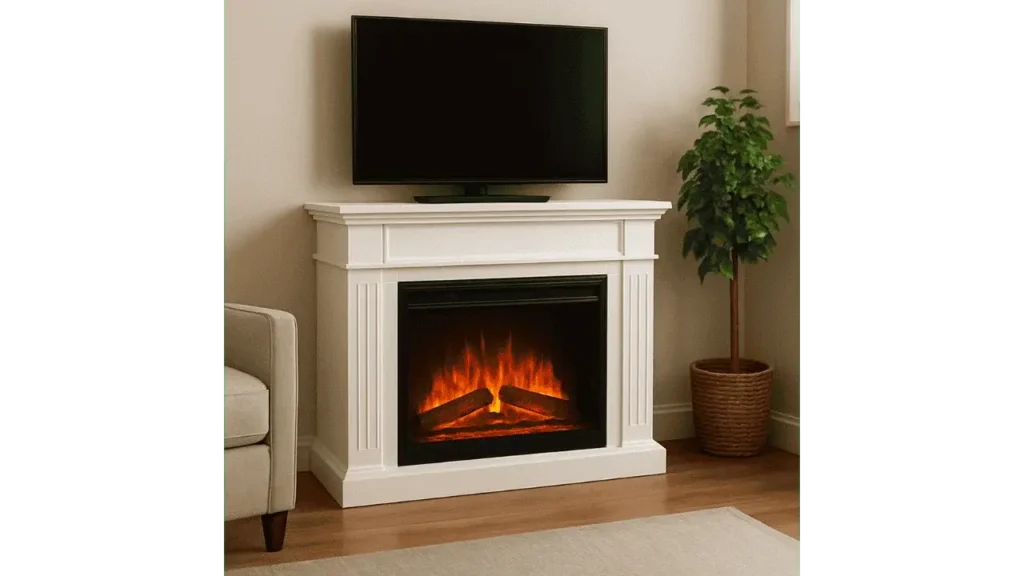Electric fireplaces have become a go-to choice for many homeowners seeking a cozy ambiance without the hassle of wood or gas. They’re sleek, easy to use, and energy-efficient, but are they really safe? While they eliminate many traditional fire hazards, electric fireplaces still come with their own considerations. Understanding how they work, their built-in safety features, and how to use them responsibly can offer both peace of mind and year-round warmth. As safety consultant Aaron Vickers notes,
“Electric fireplaces, when used correctly, are among the safest heating options available for residential use.”

Understanding the Basics of Electric Fireplaces
How Do They Work?
Electric fireplaces operate by drawing in cool air, heating it using a coil or infrared technology, and then pushing the warmed air back into the room. The flame effect is generated using LED lights and a rotating mirror element to create a realistic visual.
Key Components and Heat Mechanisms
Most electric fireplaces feature adjustable thermostats, fan-forced heaters, and remote controls. These allow for a customized experience, offering heat and visual flame control independently.
Differences from Traditional Fireplaces
Unlike wood or gas fireplaces, electric units don’t produce actual flames, ash, or smoke. They don’t require chimneys or venting, which reduces installation risks and air quality concerns.
Built-in Safety Features
Automatic Shutoff Systems
One of the primary safety features in modern electric fireplaces is the automatic shutoff system. This function detects overheating and powers off the unit to prevent fire hazards.
Cool-to-Touch Surfaces
Electric fireplaces are designed to stay cool to the touch, even during extended use, making them safe for households with children or pets. As Dr. Nina Greyson, a home safety researcher, explains,
“The external casing of an electric fireplace is engineered to remain cool, minimizing burn risks and accidents.”
Overheat Protection Technology
Many models also come with built-in sensors that constantly monitor internal temperatures. If the temperature exceeds safe limits, the unit shuts off immediately. This feature protects both the user and the appliance from malfunction or fire.
Common Safety Concerns
Risk of Fire: Myth vs Reality
Electric fireplaces do not have open flames or produce embers, which significantly reduces fire risk. However, like any electrical device, faulty wiring, poor placement, or misuse can introduce hazards.
Can They Be Left Unattended?
It is generally safe to leave an electric fireplace running while you’re in another room, provided it meets modern safety certifications. That said, it’s still wise to turn it off before leaving the house or going to bed.
Are They Safe for Homes with Children or Pets?
Thanks to the cool-to-touch design and lack of combustible fuel, electric fireplaces are much safer for environments with children or animals. Proper wall mounting or floor placement adds an extra layer of stability.
Best Practices for Safe Usage
Where and How to Install
Place the fireplace on a flat, stable surface away from moisture-prone areas like bathrooms or kitchens. Follow all manufacturer instructions and avoid DIY wiring. Professional installation is recommended for wall-mounted units.
Extension Cord Cautions
Avoid using extension cords. Plug the unit directly into a wall outlet. Extension cords can overheat and cause electrical fires if they’re not rated for the power load.
Regular Cleaning and Maintenance
Dust buildup around vents can hinder performance or cause overheating. Unplug the unit before cleaning. Lightly dust the interior and exterior with a dry cloth, and schedule occasional professional inspections.
Comparing Safety: Electric vs Gas vs Wood-Burning Fireplaces
Emissions and Air Quality
Electric fireplaces emit no carbon monoxide, soot, or smoke, making them ideal for indoor air quality. In contrast, wood-burning and gas fireplaces release combustion by-products that may pose respiratory risks.
Physical Burn Risks
Gas and wood fireplaces can become dangerously hot and cause serious burns. Electric models remain safe to touch, even during operation.
Maintenance Demands
Electric fireplaces require minimal upkeep compared to traditional options. There’s no ash cleanup, chimney sweeping, or gas line inspections to worry about.
Final Takeaways
Electric fireplaces are among the safest heating alternatives available, especially for families with kids or pets. With features like auto-shutoff, cool surfaces, and emission-free operation, they combine functionality with peace of mind. By following safety recommendations and handling installation and maintenance properly, you can enjoy the comfort and charm of an electric fireplace without worry. As long as it’s used thoughtfully, this modern heating solution offers reliable warmth and safety year after year.
- How to Install an Electric Fireplace Insert? - May 15, 2025
- How to Turn On an Electric Fireplace? - May 14, 2025
- Are Electric Fireplaces Safe? - May 13, 2025

